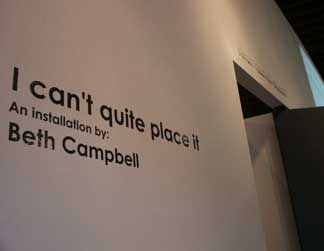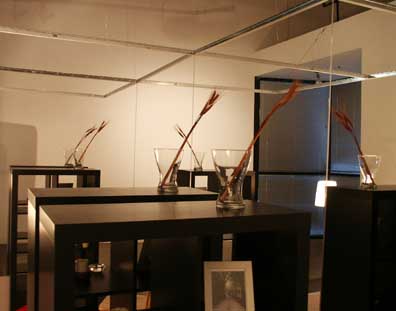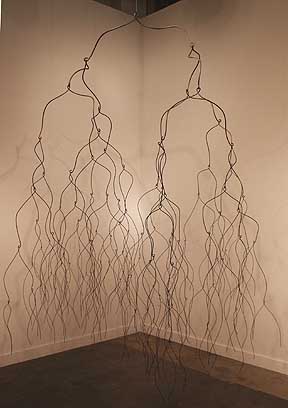
|
||
|
Portland art blog + news + exhibition reviews + galleries + contemporary northwest art
|
||
Beth Campbell at PNCA's Feldman Gallery For every action, there is an equal and opposite reaction - Sir
Isaac Newton's third law of motion
 a portion of Beth Campbell's The Following Room (2007) at PNCA Art can get lost in the paradoxes it courts and sometimes that is a good thing. Yes, some contemporary art is designed to ingratiate itself by reaffirming the tastes of those who see it, whereas other work is designed to confront and challenge those expectations. Beth Campbell's show at PNCA's Feldman gallery is mostly of the challenging journey variety. It has a kind of magic despite the fact it goes pretty much nowhere through its use of a series of faux mirrors. The effect is a bit like the Bermuda Triangle in an Ikea store, or a kind of physical paradox where pop culture meets nameless individual. The important part is how viewer gets a little lost and discombobulated by the experience forcing them to question the way optics and cognition converge. Getting lost has an important and pervasive history that can't be ignored. Great literary characters like Melville's Ishmael or cheesy self help books are both built on the idea that one has to lose themselves in order to find oneself. In Chinese philosophy Mencius focused on the internalization of one's external world to stay true to it (as selfish selflessness?). Similarly the western philosopher Wittgenstein focused on the human tendency to solipsisticly see one's self as the center of the universe. Carl Jung considered getting lost part of the "Hero's Journey" too. Then there is the long history of ascetic monks who withdraw from society to get closer to their God. Similarly Epicureans withdrew to a private life of personal appetites that seems to be a Yuppie koan these days. Of course there are dangers and merits to all of these approaches.  Yayoi Kusama's INFINITY MIRRORED ROOM 2002 rain in early spring (2002) at CAMK Today, the human impulse to get lost in a world of one's own devising seems to be especially relevelant. Of particular note is the online popularity of Second Life and in recent political history the use of faulty weapons of mass destruction assumptions to justify the invasion of Iraq. These are restless times but change seems far off. This peculiar "American Stasis" speaks to a general frustration over being stuck in a war without end and the continuing impasse over the same old problems of education, health care, infrastructure and ecology. This societal stasis underscores an uneasy American psyche that parallels a longstanding existential malaise in Europe. In other words paradox is big right now. In contemporary art Yayoi Kusama uses polka dots and often mirrors to create endlessly uneasy similarities. Likewise, Olafur Eliasson, Josiah McElhny, Damien Hirst, Gilbert & George and David Altmejd all use mirrors or mirror images to evoke both the infinite and the solipsistic. 
Enter Beth Campbell, one of contemporary art's most promising new poets of the visual stalemate. Her work resonates between infinite choices and the existentially similar outcomes that arise from making those decisions. Campbell has done maniacal videos of herself doing the same thing in different places as well as charts of her various options and the predicted outcomes in the past but her latest installation at PNCA seems to get at the heart of the issue, getting lost within the options present right where you are. Not an easy thing to do in an age of global positioning systems and signature architecture… or is it? Titled "I can't quite place it" the text outside the Feldman gallery walls for the first time in recent memory seem like an integral part of the show. Sure it's your standard black letters on the standard art institution white wall but it feels like an "institutional"… correction make that a "zeitgeist critique." It's not a question directed at anyone, it's a mantra, a motto and a probably a critique. 
The Following Room (2007) The title of the main installation "The Following Room" inside the gallery certainly supports that institutional critique reading while further complicating matters. What we find in The Following Room is faux illusion. It is constructed as a series of IKEA-like furniture vignettes that each sport a lamp, chair, book, an unused doggie chew bone, candle reading glasses and a notepad with what we assume is the artist's phone # since it says "Me". Banal as it gets really, except that Campbell has repeatedly cloned this room, installing most as mirror images to one another. A dropped ceiling grid for acoustical tile and some Plexiglas rods that mimic the edges of mirrored glass nearly completes the illusion of mirrored home furnishings of this not exactly fun house too. The illusion is purposefully incomplete too because the asymmetrical nature of the Feldman gallery allows one to orient oneself slightly amongst the disorienting white walls. This element is very intriguing. 
Unlike a MC Escher style visual bon mot, The Following Room is a question inducing experience and owes more to Robert Iriwin's reflexive or zen sense (and maybe his famous student Ed Ruscha's mirror image paintings). Still, the solipsistic tone of the work is definitely more East Coast and neurotic with the telling inclusion of a book whose title is, "The Other Side of Me." The effect is a compressed, slightly irritating form of internal self awareness that allows the viewer and work to both resonate and establish boundaries. Since borders of the various rooms are illusionary it makes one question the viewer/art boundary. The installation is effective in these respects; it's more than a sight gag or a fun house and it redirects the viewer's outward gaze inward where one wonders whether they are shopping or trespassing? …probably both. The following room is an intellectual irritant, a study in the pleasant aspects of symmetry and an experiential placebo effect. Is that enough? Frankly, I'm on a fence about it seeming too witty and entertaining but I think that's the stalemate Cambell is seeking.  Untitled (2007) The untitled bent wire sculpture in the other room seems underwhelming considering the stalemated chess match played out in "The Following Room." Similar sculptures have had names like "There's no such thing as a good decision" so sure it's a visual illustration of Campbell's option tree lists but optically it lacks the pop over familiarity and punch of The Following Room. In this case the abstracted distance is less convincing and the work of Donald Judd, or sol LeWitt make it look half hearted market fodder. Campbell is due for a solo show at the Whitney in February 2008 and perhaps that is the best time to really gauge this artist. She's both intriguing and irritating in a good way but one wonders how much range she has. Still this show is also a major coup for PNCA whose new Ford endowment has delivered Portland a very interesting show. Is Beth Campbell all smoke and mirrors, is she just another entertaining artist that major museums need to bring people in the door? Maybe, maybe not…. I sense that with pieces like The Following Room she might have her finger on the pulse of something telling without giving us anything specific. I can't place it indeed; perhaps getting lost isn't such a bad thing. Wherever you go, there you are - Confucius Posted by Jeff Jahn on November 10, 2007 at 17:21 | Comments (3) Comments The phone number calls a woman named Melissa (or Michelle, I can't remember) that lives in Washington DC. Posted by: Calvin Ross Carl Thanks for the interesting review. I had a slightly different take on this piece I'd like to share. While this work is formally similar to Kusama, I find it to operate in a way that is exactly the obverse. A disorienting perceptual shift definitely results from The Following Room, but unlike Infinity Mirrored Room or Samaras’ Mirrored Room, I don’t think that is the ultimate subject. In fact, while Kusama and others use the ACTUAL to create an ILLUSION, this piece uses an ILLUSION to create the ACTUAL. The illusion is itself an illusion - as you say, a faux illusion. So rather than feeling “lostness”, I find this to be an incredibly lucid statement. My thoughts turned to a different subtext, that of the expression of “individuality” in a mass-produced culture. It is possible (and fairly common) to create a “personalized” living space entirely from mass-produced goods, which in their differences from one another, are “infra-thin”. The Following Room carries this idea to a logical extreme, and rather than getting lost in an infinity of self-reflections, it is precisely the lack of reflection that gives this piece away (and roots it solidly in the real). Posted by: seth I thought about adding in the Samaras reference too but you are right that Campbell is working in the inverse...I described it above as "faux illusion" (which is why is why I wanted to point out how Eliasson etc utilize mirrors as mirrors).... instead Campbell creates a kind of amnesia of design through serial installation. It's definitely less driven by visual analogs (mirror reflections) than the real (and serialized) furniture etc... but Campbell still utilizes the illusion of mirrors to discomboblate the viewer... in many ways Kusama with her mirrored rooms is trying to orient the viewer in a infinite multiplicity. Campbell is less vast, and more about how the terminus of an installation synchs up with self awareness. I think Kusama tries to blow minds, Campbell is more about an more inward, reflective state (all puns intended). Posted by: Double J Post a comment Thanks for signing in, . Now you can comment. (sign out)
(If you haven't left a comment here before, you may need to be approved by
the site owner before your comment will appear. Until then, it won't appear
on the entry. Thanks for waiting.)
|
| s p o n s o r s |
 |
 |
 |
 |
 |
 |
 |
 |
 |
 |
 |
 |
 |
 |

|
Site Design: Jennifer Armbrust | • | Site Development: Philippe Blanc & Katherine Bovee | |


![[TypeKey Profile Page]](http://www.portlandart.net/nav-commenters.gif)